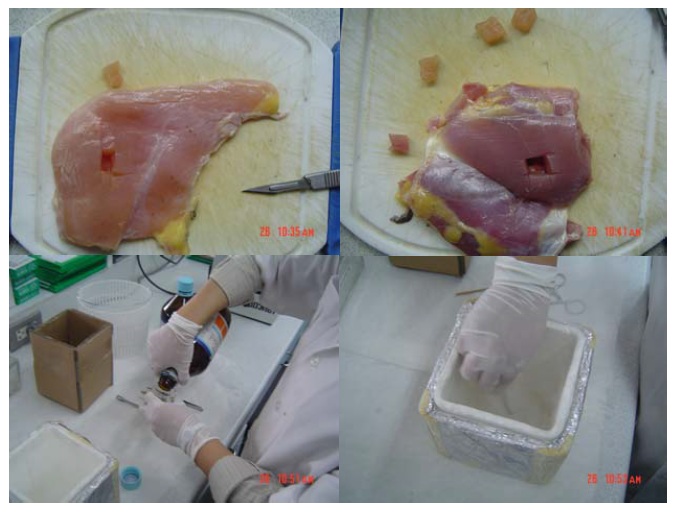วันอังคารที่ 20 สิงหาคม พ.ศ. 2556
Higher pH values predict more tender pork
Pork with a higher ultimate pH --> more water during storage --> more juice after preparation of the meat --> give a juicier, more succulent and tender eating experience.
Read more: Pork Quality: pH Decline and Pork Quality
วันจันทร์ที่ 19 สิงหาคม พ.ศ. 2556
Tenderness of meat: effect of growth rate
Effect of pig growth rate and health status on meat eating quality
D Zammerini et al. University of Bristol & university of Leeds, United Kingdom
Factors were 3 growth categories (Fast, Slow and Interrupted).
Growth rate was measured between weaning and slaughter.
There was a strong tendency for toughness to be lower in the Fast group but a significant growth category x carcass weight interaction prevented
this being a statistically significant effect. Results in Table 2 show that toughness was significantly lower in the Fast groups at
both 90 and 110 kg carcass weight. More details
Factors were 3 growth categories (Fast, Slow and Interrupted).
Growth rate was measured between weaning and slaughter.
- Guidelines for fast growth were >600 g/d to 90kg and >700 g/d to 110kg.
- Guidelines for slow growth were around 500 g/d to 90kg and 590 g/d to 110kg.
- Interrupted growth pigs were those that had suffered a period of weight loss presumed to be due to infection.
Tenderness of meat: effects of slaughter weight
Tenderness of meat from entire male pigs: effects of breed, slaughter weight and measuring method
M. Aluwé et al. Institute for Agricultural and Fisheries Research (ILVO), Animal Sciences, Scheldeweg 68, B-9090 Melle, Belgium.
Average value ± st. dev. of meat Warner-Bratzler shear force (WBSF) measurement for entire males of Piétrain (P), Belgian Landrace Stress Negative (BN) and the Large White (LW) breed slaughtered at 90 and 110 kg. More details
วันอาทิตย์ที่ 18 สิงหาคม พ.ศ. 2556
GENETIC PARAMETERS FOR LITTER SIZE IN PIGS
LITERATURE REVIEW, METHODOLOGY AND EXPERIMENTAL RESULTS By Zoran Lukovic
Litter size is one of the most important traits in overall reproductive efficiency of breeding sows. The trait has low heritability, is measured only in females and is expressed relatively late. Genetic improvement for litter size is possible due to large enough direct additive genetic variance, the availability of records on many relatives and short generation interval. Litter size is affected by many environmental and genetic factors and interaction between them. The goal of this study was to determine covariance functions for litter size i.e. number of piglets born alive using random regression model. Further, the aim was to compare it with estimates of genetic components obtained by using repeatability and multiple-trait model. |
| The Genetics of the Pig by Max F Rothschild Buy new: $232.75 / Used from: $134.92 Usually ships in 24 hours | |
| Potbellied Pig Behavior and Training: A Complete Guide for Solving Behavioral Problems in Vietnamese Potbellied Pigs, Revised Edition by Priscilla Valentine Buy new: $20.46 / Used from: $16.11 Usually ships in 24 hours | |
| Genetics and the Behavior of Domestic Animals, Second Edition Buy new: $80.89 / Used from: $83.96 Usually ships in 24 hours | |
วันเสาร์ที่ 17 สิงหาคม พ.ศ. 2556
Muscle Fiber Typing
Muscle fiber typing is conventionally performed using mATPase enzyme histochemistry on cryostat sections.
Muscle fiber profile (SO = slow oxidative fiber; red fiber; type I, FOG = fast oxido-glycolytic fiber; intermediate; type IIA and FG = fast glycolytic fiber; white fiber; type IIB)
Both Pectoralis and Bicep Femoris muscles were dissected from each specimen and quickly frozen by whole immersion in isopentane that was cooled in liquid nitrogen. The frozen muscles were wrapped in aluminum foil, placed in sealed plastic bags, and stored at –80°C until they were used for sectioning and staining.
Muscle samples were stored at -80 C, Sectioning muscle samples by cryostat.
Staining slides, mounting slide with coverslip, checking quality before analyzing with the software so called IT3 image analysis.
วันศุกร์ที่ 16 สิงหาคม พ.ศ. 2556
Drip loss and Meat Quality
Meat with a high drip loss has an unattractive appearance
- Poor color
- low consumer acceptance
- loss of sales
What is Pyrosequencing?
Pyrosequencing is a novel method of DNA sequencing based on the
"sequencing by synthesis".
The principle developed in the 1990 by Mostafa Ronaghi, then further by Biotage.
The method is based on a chemiluminescence enzymatic reaction.
Light without heat as the result of a chemical reaction.
The principle developed in the 1990 by Mostafa Ronaghi, then further by Biotage.
The method is based on a chemiluminescence enzymatic reaction.
Light without heat as the result of a chemical reaction.
Loin Eye Area Calculation from ImageJ Image Analysis Software
Using ImageJ software to calculate the area from digital image captured from a single ultrasonic measurement.
สมัครสมาชิก:
บทความ (Atom)







